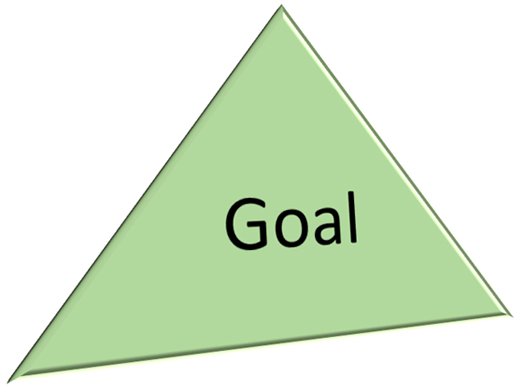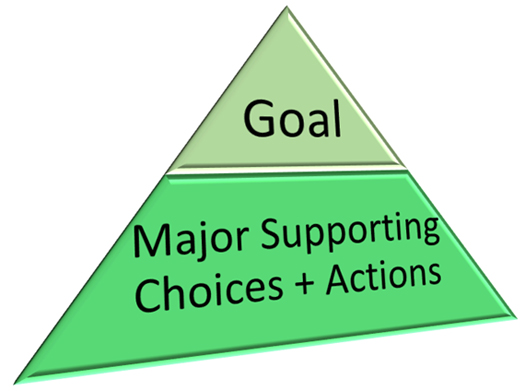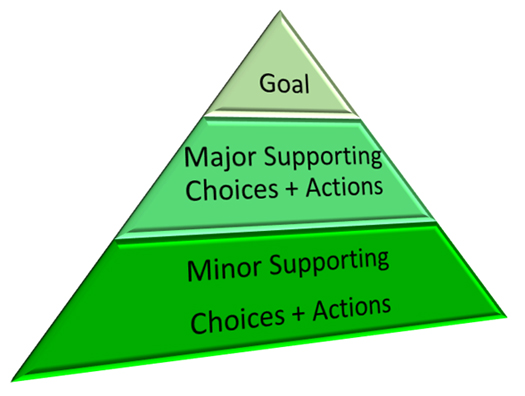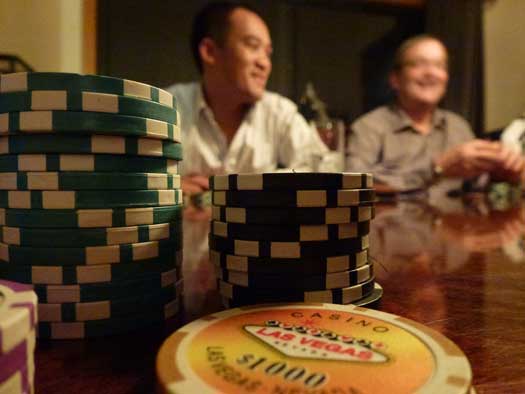Tharp's Thoughts Weekly Newsletter (View On-Line)
-
Article The Commitment Pyramid: A Project Marathon Update by R.J. Hixson
-
-
Trading Tip An Indicator Losing Its Edge: A Follow-up Analysis of the January Barometer by D.R. Barton, Jr.
-
Fun Check out Photos from Poker Night with Van!
NEW! E-Learning Course
The ABCs of Trading
If you are a beginner and want to learn about the basics of trading, this is the perfect course for you. And it's only $49.00! Learn more...

The Commitment Pyramid: A Project Marathon Update
by R.J. Hixson
Among other tasks, Van requested that I review the chapter on commitment in the Peak Performance Home Study Course and this reminded me of a tale. I would gladly reference the source, but I don’t recall the book in which I read it. The story goes something like this. A proud mother took some of her son’s paintings to an artist. The artist looked at them and said the paintings showed talent. The mother pressed, “Yes, but could he be a great artist?” The artist replied, “If he gets up day after day, year after year to paint and develop his talents, then he may become a great artist.”
If you didn’t know already, Van is really big on commitment as a key personal attribute for becoming a great trader. Rereading his chapter on commitment has highlighted for me how uncommitted I have been to trading excellence over the last two years. I have been surprised to realize all the different ways that I’ve been uncommitted to my goal of being a great trader.
Since this whole idea of commitment has been bouncing around my head for the last few weeks, will you permit me to get a few thoughts down on paper? Or maybe more accurately, on the screen.
A Commitment Model
The idea that commitment is not a once and done kind of thing is old news. Commitment is a process that requires recommitment after recommitment. You aren’t committed to your spouse when you say "I do" at the wedding and then that's it. You recommit constantly to the relationship through choices and actions—those that are “big” or infrequent, and those that are small and everyday.
Along these lines, it seems that any commitment is something of a pyramid that starts with a goal.*

Having great desire for a goal is all well and good, but achievement of that goal requires commitment which translates that desire into a host of supporting choices and actions. Any major goal requires some major decisions at a structural level to support the achievement of the goal, which can be graphically represented by a supporting layer under your goal.

Choices at this level involve significant time and effort. Athletes seeking a gold medal at the Olympics next summer had to make choices years back dedicating a large part of their lives to training. They also had to find great coaches, and they have needed to compete and win in many preliminary events leading up to the Olympics. For traders, the equivalent major supporting choices and actions include securing sufficient capital, writing a business plan, understanding how to manage risk, and knowing or learning the basics of trading or how markets function.
Beneath the level of major choices and actions is the base level of the pyramid where commitment to the goal generates a host of minor supporting choices and actions. These include the “little” choices and actions required to be made on a daily, hourly or even minute-by-minute basis that must be handled and handled well, down to the smallest of details.

Rinsing Your Cottage Cheese
The following story relates a champion's commitment to excellence down to the smallest of details and comes from Jim Collin’s business book, Good to Great. David Scott has won the Hawaii Ironman Triathlon a record six times. In training, Scott would average 20,000 meters of swimming, 75 miles of biking, and 17 miles of running each day. Burning many thousands of calories per day, you probably wouldn’t think that Scott need concern himself about ingesting a few extra calories per day—but he did. He would literally rinse his cottage cheese to remove extra fat from it before he ate it. Was this his secret to winning the Ironman? No, however, such an act of daily attention to the smallest matters clearly shows the level of commitment that champions give to their goals.
We have a model for someone who washes his cottage cheese in a trading sense. Ken Long provides an excellent example by framing the reward-to-risk ratio for potential trades beforehand, marking up screen captures of charts after every trade with an assessment, diligently preparing his weekly trading view and daily trading plans, and much, much more.
Ken regularly shares that he views trading as a craft, and he often refers to the craft guild approach to improving his trading skills. By putting in the time and effort as an apprentice and journeyman, someone can eventually move to the level of the craftsman or master craftsman. Ken refers to himself as an apprentice and the small things he does as simply shoveling more coal or laying one more brick.
On a Personal Level
So what’s missing in the area of commitment for me? Well, quite a lot as it turns out. I’ll start at the top of my commitment pyramid and summarize my way down.
My Goal. My primary long-term trading goal has grown quite fuzzy over the last two years. I hadn’t looked at my long-term plans in a while believing they were fine from when I last went through the exercise. In the last few years, however, my kids have gotten older, I have gained a better understanding of what I want in the next ten years, and my ideas about what I could achieve through trading have evolved as well. But I had yet to incorporate any of that into my long-term trading objectives. I’m updating that now by spending a lot of time on those longer term objectives, modeling some of it in spreadsheets, and writing about it in as much detail as possible.
My Major Support Level. Actually, I have a good bit of the major support in place: trading capital, time to trade, basic knowledge, etc. I have, however, been missing a strong trading plan that included a sufficient number of trading systems for different market types, a defined method of when to start and stop trading a system, and a position sizing™ strategy for each system that would help me reach my trading goals.
My Minor Support Level. I haven’t been rinsing my cottage cheese. Shoot, I haven’t even been eating cottage cheese in many cases. Here are just a few of the “small” matters that I’ve neglected: sufficient daily and weekly preparation processes to trade, sufficient daily and weekly evaluation processes for trades, consistent execution of the top tasks of trading, and sticking to my schedule. It feels like I have the most work to do in this area.
The mechanical elements that are missing from each level above all have psychology underpinnings—some overt and some quite subtle. Regardless, they are all trading mistakes for which I’m responsible. Furthermore, their long-running repetition reveals a lot of self-sabotage. Acknowledging and addressing this point has seemed to generate some resistance inside me very recently, so I need to review Van’s work on that.
What’s Next
As I’ve been reviewing commitment over these last few weeks, my energy to recommit at each level has grown. I’m recommitting to my big goals (now clarified) and recommitting to all of the subordinate choices and actions as defined by a checklist I created for the missing parts. I’m working through that list now, but there’s more to come.
* I searched online for this model as I don’t imagine it’s new. It’s not related to Maslow’s Pyramid of Commitment, but I couldn’t find it referenced on-line elsewhere.
About the Author: RJ Hixson is a devoted husband and active father. At the Van Tharp Institute, he researches and develops new products and services that will help traders trade better. While he has enjoyed the very mild winter in North Carolina to date, he's hopeful to experience at least one snowfall before spring. He can be contacted at “rj” at “vantharp.com”.
Trading Education
Workshops
A Mid-March Peak Performance 101 Has Been Added in Sydney!
Oneness Awakening
February 11-12
Cary, NC
|
The workshop has become a fundamental tool in
Dr. Tharp's mission to help his clients succeed.
Don't miss a chance to learn more about
how you can become more aware,
positive, calm, centered, and successful. More... |
Blueprint for Trading Success
February 24-26
Medina Hotel Sydney AU
|
This is a complete structured program in which you’ll learn strategic, focused steps that will serve you throughout your entire trading career. During these intensive, hands-on three days, you will learn 17 clear and concise tasks to master that will take your trading from ho-hum to visionary. You will leave with a thorough checklist of action steps to guide you to a higher level of performance. More... |
How to Develop a Winning Trading System That Fits You
February 28-Mar 1
Medina Hotel Sydney, AU
|
Our job in this workshop is to teach you what you need to know to develop your own system. The material you will learn is not market or time-frame specific. So whether you trade stocks, futures, currencies or gold, etc., or whether you place 50 trades per day or 50 trades per year, you will learn all of the components that work in any system. More... |
Peak Performance 101
March 17-19
Mercure Hotel Sydney AU |
Understand why some people consistently make profits over and over again, while others are erratic and unsuccessful. More importantly, you’ll learn how to overcome self-sabotage and develop rock-solid discipline in your performance in the
markets! More... |
More upcoming workshops in Cary, NC
- March - Mechanical Day and Swing with Ken Long
- March - Discretionary Live Trading with Ken Long
- April - Core Systems that Outperform with Ken Long
- April - Blueprint for Trading Success with Van and RJ
- May - Peak Performance 101 with Van Tharp
- May - Peak Performance 202 with Van and Libby
Click here to see the full workshop schedule and more more info |
 Trading Tip Trading Tip
An Indicator Losing Its Edge: Follow-up Analysis on the January Barometer
by D.R. Barton, Jr.
Last week we looked at yet another January indicator—the January Barometer. Yale Hirsch devised this indicator in the 1972 Stock Trader’s Almanac, and it states that as the S&P 500 goes in January, so goes the year.
In past decades, it has posted a very impressive track record. But in the last eleven years, it seems to have lost its magic. I mentioned last week that the January Barometer has only been helpful in four of the past eleven years, with four losing years for the indicator and three flat years (years when the S&P 500’s gain or loss was within +/- 5% for the year).
This analysis was enough be for me to file the indicator in the “interesting and used to work” file. However, an astute reader from Denmark sent us an email asking about total returns from the years in question.
As most of you know, Van strongly believes that percent wins is much less an important measure than system expectancy (how much a system returns, on average, per dollar risked). So the question from the land of tasty beer and mermaid statues prompted additional analysis.
As an aside, I visited Denmark years ago after I graduated college. We made the tactical error of touring the Carlsberg brewery before seeing the famous statue of the Little Mermaid in Copenhagen Harbor. I vaguely remember the Little Mermaid appearing quite fuzzy and out of focus. It is possible that I even saw two of her at the time.
But back to the January Barometer. Could the strength of a few winning years overcome the flat and losing years between 2001 and 2011 for this once consistent indicator?
Bad News for the January Barometer
From a strategy perspective, the indicator has lost its luster and shows itself to be a negative performer. When we add up the annual percentage gains for the years the January Barometer was right and subtract the percentage losses for the years it was wrong, we find a barely positive outcome. Even a monstrous gain of 38.5% for the correctly predicted 2008 swoon could only make the strategy ever-so-slightly positive for the eleven-year period in question.
In the last eleven full years, if we take the winning total year percent gains and subtract the losing year percent losses, we get 9.3% for the whole period, or 0.85% per year. This is no different than a coin flip and lower than the rate of inflation (or passbook savings). And again, this is with the big win of 38.5% in 2008.
However, the actual results would have been worse if you had tried to “trade” this as a strategy (not just use it as a predictor of price direction) because you could not enter until the signal triggers—at the end of January. You would have had to subtract the positive gains for January in those years. Up Januarys that led to down years would result in even bigger losses than reflected in the figures above (the same calculation holds for down Januarys). In short, the “strategy” actually has to subtract out the absolute move for each January, a deduction which totaled -34.3%. Trading this strategy would have generated a net loss of 25% for the last eleven years. Ouch! Maybe this is becoming a strategy to fade instead of follow!
The bottom line is that the January Barometer is now the January Bum, and has been since 2001. So don’t worry about how we end the month of January next week—that really isn’t going to tell you how the market year will end.
As always, I’d love to hear your thoughts or feedback on these ideas. Email me at drbarton “at” vantharp.com.
Great Trading,
D. R.
About the Author: A passion for the systematic approach to the markets and lifelong love of teaching and learning have propelled D.R. Barton, Jr. to the top of the investment and trading arena. He is a regularly featured guest on both Report on Business TV, and WTOP News Radio in Washington, D.C., and has been a guest on Bloomberg Radio. His articles have appeared on SmartMoney.com and Financial Advisor magazine. You may contact D.R. at "drbarton" at "vantharp.com".
No Shipping Costs on These Downloadable Items
The New ABCs of Trading E-course $49
The Intro to Position Sizing Strategies E-course $149
The Position Sizing Trading Simulation Game $195
The Investment Psychology
Inventory Profile $100
Two Special Reports on Self-Sabotage $19.95 ea
Special Report Does Your System Still Work in Changing Markets? $19.95
Fun
Click here to see pictures from poker night with Van and the Super Traders

(Thanks to Dave Lennard for the cool shots!)
Ask Van...
Everything that we do here at the Van Tharp Institute is focused around helping you improve as a trader and investor. Therefore, we love to get your feedback, both positive and negative!
Click here to take our quick, 6-question survey.
Also send comments or ask Van a question by using the form below.
Click Here for Feedback Form »
Back to Top
Contact Us
Email us [email protected]
The Van Tharp Institute does not support spamming in any way, shape or form. This is a subscription based newsletter.
To change your e-mail Address, click here
To stop your subscription look at the very bottom, left corner of this email and click on that link.
How are we doing? Give us your feedback! Click here to take our quick survey.
800-385-4486 * 919-466-0043 * Fax 919-466-0408
SQN® and the System Quality Number® are registered trademarks of the Van Tharp Institute
Back to Top |